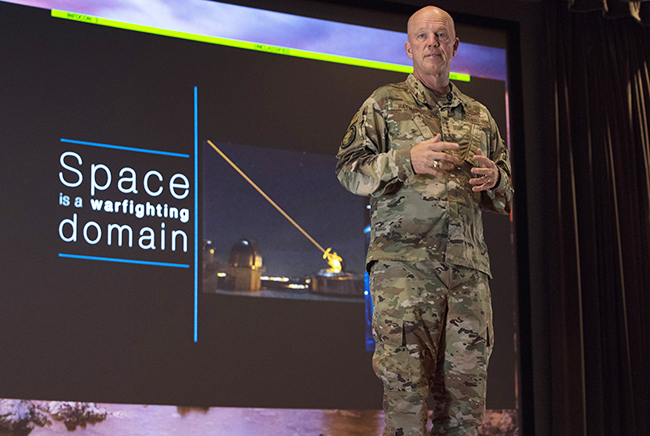
Gen. Jay Raymond, the commander of Air Force Space Command and the Joint Force Space Component Command, hosted an all-call on July 2, 2019, at Vandenberg AFB, Calif. Air Force photo by SrA. Clayton Wear.
A new US Space Command will formally launch within weeks, the deputy commander of US Strategic Command told reporters July 31.
“I think it’d probably be about weeks—we should see the actual establishment of US Space Command,” Vice Adm. David Kriete said. “I think we’re on a good track in terms of our planning.”
Kriete said the timeline for launching the revived SPACECOM, which will take over responsibility for space combat operations from STRATCOM, will be at the discretion of new Defense Secretary Mark Esper. The Pentagon has not yet announced where SPACECOM headquarters will be, but its two major components will be located at Vandenberg AFB, Calif., and Schriever AFB, Colo. The Senate recently confirmed Air Force Space Command boss Gen. Jay Raymond to lead the combatant command.
“We will continue the process that we have put in place to help grow and develop the new command, such that—at the right time, at the right pace—they can become fully functional and effective as an independent combatant command,” Kriete said.
Defense officials are still working out the details of which missions, resources, and authorities SPACECOM will take on and when, without shortchanging the Pentagon’s current ability to operate in and defend space. The command’s work on its first day will encompass tasks done by the existing Joint Force Space Component Command, which reports to STRATCOM and is run by Raymond. SpaceNews reported in June the JFSCC is forming the basis of SPACECOM, and two new major components will split up the combatant command’s daily tasks of supporting field commanders and protecting US assets.
“We can’t expect them to do everything that a normal, well-established combatant command does every day on the first day they’re established,” Kriete said. “We will slowly develop the command, grow their talent pool, the number of people assigned, the resources they have available to them, and the missions.”
He compared it to the process of growing US Cyber Command from a small mission assigned to STRATCOM into an ever-larger organization.
“SPACECOM has been on a little bit different path,” he continued. “But at STRATCOM, we certainly know how to go about establishing a new combatant command and to do it in a way that makes them successful.”
SPACECOM will oversee daily space operations using people and assets provided by the potential new Space Force and other military space groups. It is initially expected to employ more than 600 people, though the Defense Department is assessing the overall size, structure, and resource needs. The department’s 2020 budget request includes about $84 million to stand up the command.
